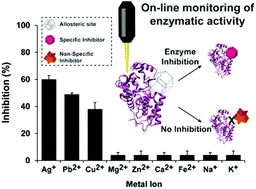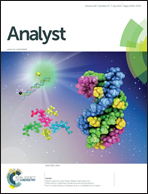Detection of trace heavy metal ions in water by nanostructured porous Si biosensors†
Abstract
A generic biosensing platform, based on nanostructured porous Si (PSi), Fabry–Pérot thin films, for label-free monitoring of heavy metal ions in aqueous solutions by enzymatic activity inhibition, is described. First, we show a general detection assay by immobilizing horseradish peroxidase (HRP) within the oxidized PSi nanostructure and monitor its catalytic activity in real time by reflective interferometric Fourier transform spectroscopy. Optical studies reveal the high specificity and sensitivity of the HRP-immobilized PSi towards three metal ions (Ag+ > Pb2+ > Cu2+), with a detection limit range of 60–120 ppb. Next, we demonstrate the concept of specific detection of Cu2+ ions (as a model heavy metal) by immobilizing Laccase, a multi-copper oxidase, within the oxidized PSi. The resulting biosensor allows for specific detection and quantification of copper ions in real water samples by monitoring the Laccase relative activity. The optical biosensing results are found to be in excellent agreement with those obtained by the gold standard analytical technique (ICP-AES) for all water samples. The main advantage of the presented biosensing concept is the ability to detect heavy metal ions at environmentally relevant concentrations using a simple and portable experimental setup, while the specific biosensor design can be tailored by varying the enzyme type.


 Please wait while we load your content...
Please wait while we load your content...